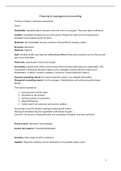Samenvatting
Financial and Management Accounting I summary
A summary of financial accounting chapter 1, 2, 3 + management accounting chapter 1, 2, 3 + power points and lectures. With examples and definitions of terms. It is based on the course of International Business Year 1
[Meer zien]




